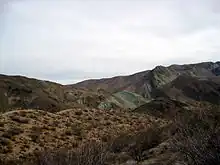Jawbone Canyon
Jawbone Canyon is a geographic feature in the Mojave Desert and a Bureau of Land Management area located in Kern County, California, 20 miles (32 km) north of Mojave on CA 14 near Cantil, CA. The area is a popular destination for hikers and off road vehicle enthusiasts.

History
Europeans first settled in the canyon around 1860—naming it Jawbone because its shape resembled a mandible[1]—and the trail was used as a trade route from Keyesville into the Piute Mountains (not to be confused with the Piute Mountains of the eastern Mojave Desert). During the Kern River gold rush, several gold mines operated in the canyon; the most successful of these, the St. John mine, yielded nearly $700,000 worth of gold between 1860 and 1875. The Gwynn mine, on the Geringer Grade, ran six claims yielding a total of $770,000 worth of gold and quartz before ceasing operations in 1942. Mining continued throughout the 1940s, mainly focused on rhyolite and antimony.[2]
The area has been used for recreation since the early 20th century. A scientific study, published in 1983, shows that extensive environmental damage had been caused by off road vehicles operating in Jawbone Canyon.[3] Although off-roading is still permitted in the recreation area, as the Jawbone-Butterbredt Area of Critical Environmental Concern riders are restricted to established trails.[4]
Features
- The largest sag pipe of the Los Angeles Aqueduct crosses through Jawbone.[5]
- Blue Point, a large hill covered with blue-green stone, marks the entrance to Alphie Canyon. The color is due to oxidized copper in the rock.[6][7]
- The Tehachapi Pass Wind Farm is visible from the eastern end of the trail.[2]
- Jawbone Canyon road terminates at Piute Mountain Road, inside Sequoia National Forest.
- Jawbone-Butterbredt Area of Critical Environmental Concern
 Large deposits of volcanic rock in Jawbone Canyon
Large deposits of volcanic rock in Jawbone Canyon The floor of Jawbone Canyon
The floor of Jawbone Canyon The north-east of Jawbone Canyon
The north-east of Jawbone Canyon Yucca brevifolia or Joshua tree at Jawbone Canyon
Yucca brevifolia or Joshua tree at Jawbone Canyon Sandstone caves in Jawbone Canyon
Sandstone caves in Jawbone Canyon Looking north along the Los Angeles Aqueduct in Jawbone Canyon
Looking north along the Los Angeles Aqueduct in Jawbone Canyon
See also
Index
- Category: Flora of the California desert regions
- Category: Fauna of the Mojave Desert
- Category: Protected areas of the Mojave Desert
References
- Gudde, Erwin G.; Bright, William (2004). California Place Names. University of California Press. p. 183. ISBN 0-520-24217-3.
- Massey, Peter; Wilson, Jeanne (2006). Backcountry Adventures Southern California. Adler Publishing. p. 187. ISBN 1-930193-26-2.
- Webb, Robert H.; Wilshire, Howard G. (1983). Environmental effects of off-road vehicles: impacts and management in arid regions. Springer-Verlag. ISBN 0-387-90737-8.
- Jenkins, Jim C.; Jenkins, Ruby J. (1992). Exploring the Southern Sierra. p. 28. ISBN 0-89997-128-8.
- "CA4933: Los Angeles Aqueduct Jawbone Canyon Siphon". Center for Land Use Interpretation. Archived from the original on November 21, 2008. Retrieved January 2, 2010.
- Huegel, Tony (2001). Sierra Nevada Byways: Backcountry Drives for the Whole Family. p. 52. ISBN 0-89997-273-X.
- Massey, Peter (2006). California Trails Central Mountains Region. Adler Publishing. p. 104. ISBN 1-930193-19-X.